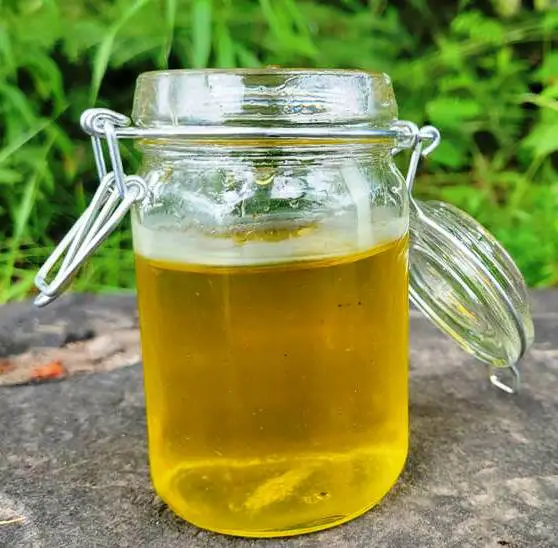Estimated reading time: 11 minutes
Enjoying the outdoors in the summer months can lead to painful rashes and itchy bumps thanks to poison ivy and biting insects. People tend to turn towards commercial products to help them soothe the pain, not knowing that there is a natural alternative readily available around them.
A jewelweed salve is made from a commonly found plant in North America and provides relief for a variety of skin conditions. It is easy to make and can be crafted for much less money than the stuff you buy at the store.
This guide will teach you everything you need to know about jewelweed. You’ll learn how to make your salve and the benefits of having some in your kit when you're outdoors.
Want to save this post for later? Click Here to Pin It On Pinterest!
What is Jewelweed?

Jewelweed (Impatiens capensis), also called Touch-Me-Not is a flowering annual plant that has been used in traditional Native American medicine for healing various ailments. It is generally made into a multi-purpose salve that can be stored for months without showing signs of degradation.
It is widespread in Northern and Eastern North America. You’ll find it in forested floodplains and lining the edges of bogs and marshes. Often it can be found lining roadside ditches where culverts direct water.
Jewelweed grows in the same habitat as stinging nettle (Urtica dioica) and poison ivy (Toxicodendron radicans). If you’re in doubt about whether or not there is jewelweed in the area, check for these other plants as an indicator that there is a possibility that it grows there.
Ironically, jewelweed can be used to treat the stinging effects of both of these plants.

It is identifiable before August by its oval leaves with toothed edges that are alternately occurring on the stem. After mid-summer and until the first frost they will be mature and display beautiful orange flowers. The plant is used both when it’s flowering and when it’s not.

Both the stem and the leaves contain a sap that may help relieve the itchy symptoms caused from:
- Poison ivy
- Bug bites (Mosquito, black fly, horse fly, deer fly)
- Stinging nettle
- Hives
- Bee stings
You can easily grow jewelweed in your garden at home. All it requires is partial shade, rich soil, and humid climates to grow successfully, which is pretty much any temperate environment. It’ll attract birds such as hummingbirds to feed on the flowers. Bees and butterflies will also have a food source to visit throughout the summer.
How to Make a Jewelweed Salve

This simple, yet effective salve requires a few basic pieces of equipment. You can take up to 48 hours to infuse the jewelweed salve for more potency but leaving it overnight does just as good a job.
Materials:
- 1 ½ – 2 cups crushed Jewelweed stems and leaves
- 1 ¼ – 1 ½ cups of oil (olive oil works great but choose any neutral-flavored oil)
- 1 ounce of beeswax
- Optional: A drop of essential oil of your choice
Equipment required:
- Medium-sized mason jar
- A medium-sized pot
- A rock or trivet
- A container for the salve
- Cheesecloth
Directions:
1. Bruise and crush the jewelweed leaves and stems small enough to fit in a mason jar. Ensure you are packing down the leaves and fill it until there is a ¼ inch gap at the top of the jar.

2. Fill the mason jar with the oil of your choice until the leaves are covered.

3. Add 1-1.5 inches of water into your pot. Place the rock or trivet on the bottom of the pot and place the mason jar on top of it. This is so the glass does not have direct contact with the bottom of the pot.

4. Heat the water until it reaches about 120° and then shut off the heat and cover.

5. As the salve cools down, heat it back up to temperature again. The idea is to only have direct heat on it periodically. Also, keep an eye on the water level and replenish the level if it falls too low.

6. Once completed, strain the oil using the cheesecloth. Pour the warm oil into a heatproof bowl.

7. Add the beeswax to the warm oil.

8. Stir until it is smooth and even.


9. Pour the salve into its final container and let it cool down for 45 minutes before using.

It’s important to let it cool down so that the beeswax has time to set. It'll produce a soft material, with a smooth surface. Keep it away from high heat sources or out in the sun for long periods to avoid degradation of the medicinal qualities.
How to Apply the Jewelweed Salve

Before you apply the salve to the affected area you’ll want to clean the area with cold water and soap. Any soap you have on hand will work, the idea is to get the oils from the irritant off of your skin to minimize the damage. Using hot water will irritate the problem further by increasing the amount of inflammation.
Once it is cleaned and dried thoroughly you’ll want to apply a thin layer of the salve with your fingers over the affected area. Doing this as quickly as possible after exposure is important because a problem such as poison ivy will get worse over time as the irritating oils set into your skin.
The Quick Fix

A temporary solution if you don’t have any jewelweed salve in your kit is to take a part of the plant and crush it between your fingers. This will release the weary sap which can then be applied to the affected area. While it will lessen the initial sting it will lack the potency of a salve.
What Else Can You Do With Jewelweed?
Eat it: Preparing jewelweed for eating is much like preparing spinach and other greens. While it does take a while to make, having it available in a survival scenario is better than nothing. Simply boil small jewelweed plants for 15 minutes and then drain the water. Do this process again and drain it again.
Once that’s done you can fry it up with some butter or eat it as is. It is important to note that jewelweed has calcium oxalate crystals which lead to kidney stones and other bladder issues.
Make some soap: Creating a soap that can help take the itch out of poison ivy is a good way to make use of the young plants. Using lye and a fresh jewelweed infusion will create a deep olive-colored soap that will help relieve different skin irritations.
Turn it into tea: Collect a handful of jewelweed and boil some water to infuse it. Let the plant sit in the water for 20-25 minutes and then strain it out before you drink it.

Preserve it for later: Jewelweed can be frozen if it needs to be stored long-term. Any other form of storing will degrade the potent sap inside. Some people use jewelweed in soap, lotions, and other extracts
Tips for Making a Jewelweed Salve
Add lavender for relaxation: Lavender is used to help people relax before going to bed. It also helps reduce scarring and the redness associated with skin irritation.
Sage can be added for antiseptic qualities: Adding sage to your jewelweed salve will enhance it with antiseptic qualities that can help prevent infection. Simply add a small amount of sage extract to the end step of the salve-making process.
Mix English plantain with the jewelweed: Also known as Common plantain, it is widely considered a weed in North America; However, it has been shown to have powerful anti-inflammatory properties. Gather some plantain leaves and steep them with the jewelweed to increase the overall effect.
Conclusion

Jewelweed is one of those urban “weeds” that people don’t pay much attention to simply because they were not taught to look for it. It is one of the many varieties of greenery that provide therapeutic effects without the aid of synthetic medicine.
What makes natural remedies like jewelweed so powerful is their ability to complement the effects of other ingredients. Identify and research the common plants in your area and see if they have any medicinal effects that might work well in a jewelweed salve.
Jewelweed FAQ
Are there any toxic side effects from using Jewelweed?
No significant side effects have been reported from Jewelweed making it possibly safe for most people when applied to the skin.
What’s the difference between yellow and orange jewelweed?
The main difference is the color of the flowers which is related to the name. You can use either variety to help treat skin irritations in the same manner.
What animals eat jewelweed?
You’ll often find hummingbirds, bees, and butterflies eating from the flowers. However, other than goats, no other animal uses it as a source of food.
Like this post? Don't Forget to Pin It On Pinterest!
You May Also Like:












